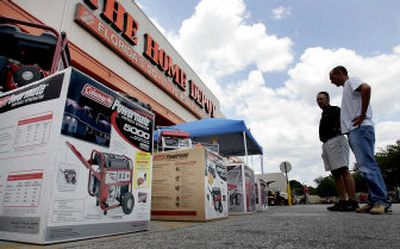Hurricane readiness in doubt

Max Mayfield, director of the National Hurricane Center in Miami, says people have to wake up.
“People who get hit by a couple of hurricanes still tend to chalk it up to bad luck or a fluke and don’t think it can happen again,” he says.
State and local governments along the Atlantic and Gulf coasts are heeding the alarm of last year’s record onslaught and forecasts of another worse-than-normal hurricane season this year. Mock disaster drills from the Northeast to Texas have tested local and regional response. States and cities have revamped evacuation plans and set up Web sites to encourage residents to prepare and store extra provisions. The Federal Emergency Management Agency, roundly criticized for its slow response to Katrina, has tripled its stock of relief supplies.
Flood barriers in New Orleans are mostly back to pre-Katrina strength after more than $700 million in repairs. But that doesn’t mean they could withstand another big hurricane. Other major metro areas along the coasts – Houston, Miami, Tampa-St. Petersburg, even New York City – are taking fresh steps to try to avoid having a hurricane nail them the way Katrina crippled New Orleans.
Despite gales of pre-season publicity, Mayfield says many people along the United States’ hurricane coasts are not poised for the next tropical storm, let alone for a monster like 2005’s Katrina. The Census Bureau says more than 34.6 million people live in the most at-risk coastal zones, from the Carolinas to Texas. That’s more than triple the population there in 1950.
Mayfield, who has barnstormed hurricane country for weeks to preach the gospel of readiness, sees trouble in a recent poll of coastal residents in 12 Atlantic and Gulf states. The survey of 1,100 people by Mason-Dixon Polling & Research found that more than half don’t feel vulnerable to hurricanes, and three in five have no family disaster plan.
The poll, released in mid-May by the National Hurricane Survival Initiative, a public-private partnership that includes the hurricane center, also found that more than two-thirds of the respondents have no hurricane survival kit. And half erroneously believe that masking tape makes windows shatterproof in a storm. Thirteen percent say they wouldn’t evacuate, even if ordered to leave.
“The folks there in Mississippi and Louisiana who made a conscious decision not to evacuate (in Katrina) were not just tempting fate, they were playing Russian roulette,” Mayfield says.
16 storms forecast
One reason for apathy may be timing. Although hurricane season starts Thursday, June and July rarely record a tropical storm more than once every other year, according to records dating to 1886. The heart of hurricane season normally is mid-August through October. The official end is Nov. 30. Last year’s record assault brought two named storms in June and five in July. There also have been tropical storms the last two Decembers.
This year’s forecast is for up to 16 tropical storms, eight to 10 of them hurricanes and as many as six of them major, meaning a Category 3 or higher with winds of at least 111 mph.
Most vulnerable this year is the battered Gulf Coast. An estimated 110,000 people who lost their homes to Katrina, Rita and Wilma now live in 39,000 government trailers. The temporary quarters are no match for a strong storm, let alone any hurricane, Mayfield says. These people must be ready to leave – quickly.
Besides holding disaster drills, states and agencies such as the Red Cross continue to stress self-preparedness. They say residents should be ready to subsist on their own for 72 hours after a storm.